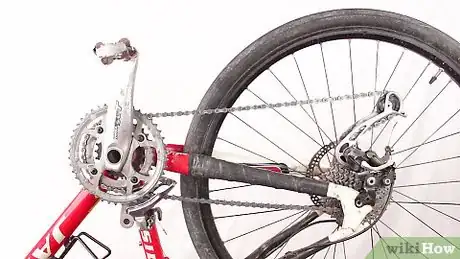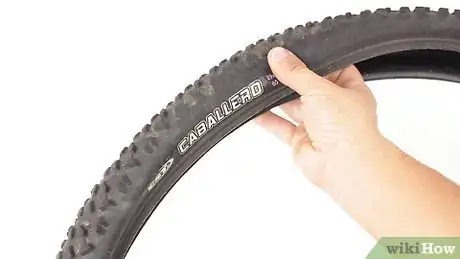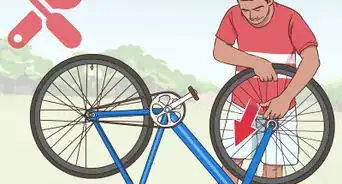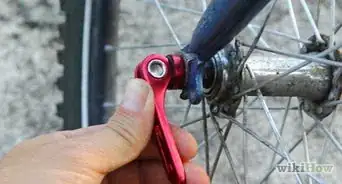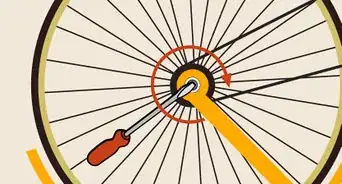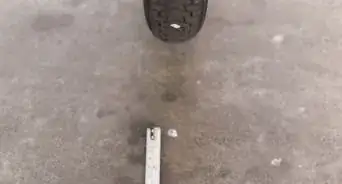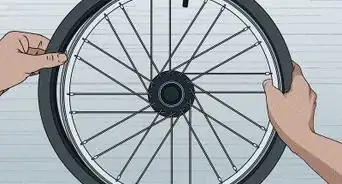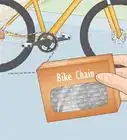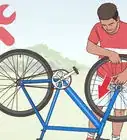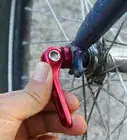This article was co-authored by Chris Atkinson and by wikiHow staff writer, Danielle Blinka, MA, MPA. Chris Atkinson is an associate at Yuba Expeditions in Quincy, California, and the former Sales Manager at Palo Alto Bicycles in Palo Alto, California. Chris has worked in outdoor sporting since 2003.
wikiHow marks an article as reader-approved once it receives enough positive feedback. In this case, 100% of readers who voted found the article helpful, earning it our reader-approved status.
This article has been viewed 1,331,249 times.
Having a flat bicycle tire can leave you stranded, but it’s simple to replace the tire yourself. Usually, this just means replacing the tube inside the tire. However, you may need a new tire if it’s very damaged or worn. Before you replace the tire, you’ll need to take it off. Then, replace the tube and tire, if necessary. Finally, put the tire back onto the wheel.
Steps
Taking Off the Wheel
-
1Put your bicycle on its side with the chain facing up. You can’t remove a tire while the bicycle is upright because it will fall over. The chain side, which is called the driving side, should always face up to avoid damaging it.
- You can also turn the bike upside down, resting it on its handlebars. Some people don’t like turning it upside down because the handlebars or seat can get damaged.[1]
- As another option, you can invest in an upright bike stand that will hold your bicycle while you work on it. You can find these stands at some bicycle stores or online. Also, you can build one yourself.
-
2Adjust your gears to the smallest ring if you’re removing the back tire. Usually, this will be the outer gear. Setting your chain on this outer, smaller gear will make it easier to remove the rear tire.[2]
- You don’t need to adjust the gears if you’re removing the front tire.
Advertisement -
3Open and remove the quick release lever, if your bike has one. Look for the quick release lever at the center of your bicycle wheel. Pull up on the lever, then turn it 180 degrees to loosen it. Remove the lever from the axle and set it aside.[3]
- If your quick release lever doesn’t come off after you turn it 180 degrees, keep turning it until you can remove it.
- If you’re not sure how to remove your bicycle tire, it’s best to check your bicycle manual or the manufacturer’s website.
-
4Use a wrench to loosen the nuts if you don’t have a quick release lever. Hook the wrench onto the nut, then turn to loosen it. Continue turning the nut until it comes off. Remove the wheel nuts on both sides of the bike.[4]
- If you can’t get the nut loose, you can spray it with WD-40 or cooking spray to make it easier to loosen it.
- A 15mm wrench is usually the correct size for loosening the nuts on a bicycle.
-
5Detach the brake cables if necessary. In many cases, opening the quick release lever also detaches the brakes. If your model doesn’t have this feature, squeeze the calipers on the brakes to release the cables.[5]
- Check your bicycle manual or the manufacturer’s website if you’re having trouble detaching your brakes. Instructions vary for different bike models.
-
6Lift the wheel off the frame. Pull the tire out of the forked slot that supports it on the bicycle. You may need to slightly shift the bike tire as you remove it.[6]
- If you’re removing a back tire, you may need to lift the bicycle chain out of the way.
Removing the Tire and Tube
-
1Deflate the tire completely. Loosen the cap on the air valve. If it comes completely off, set the cap aside. Release the air using the correct procedure for your air valve type. This will make it easier to remove.[7]
- If your bicycle has a Schrader (American) valve, use a small tool, such as your wrench, to press down on the plunger inside the air valve to release the air.
- If you have a Presta valve, unscrew and pull up on the valve cap to release the air.
- If you have a Dunlop valve, take off the cap, then pull up on the air valve to release the air.
-
2Hook the rounded edge of a tire lever under the outer edge of your tire. This will pop up the edge of the tire, releasing it from the frame. Pull the other end of the lever down toward the spokes. Next, hook the other end of the lever onto a wheel spoke to keep the edge of the tire popped up.[8]
- If you don’t hook the other end of the lever onto a spoke, your tire will go back into place and reseal itself around the wheel.
- The outer edge of a bicycle tire is called a “bead.”
- You can find inexpensive tire levers at a bicycle store, outdoor store, or online.
- You may be able to remove your tire with a spoon or screwdriver, but they can damage your tire.
-
3Work a second tire lever clockwise around the circumference of the tire. Insert the second lever near the first one, then press up on the tire. Move the lever clockwise around the tire, pushing up on the tire as you go. Keep going until the entire side is loosened from the frame.[9]
-
4Pull the tube out from inside the tire. Insert your fingers under the side of the tire. Grab the tube and slide it out. When you reach the air valve, push it through the hole on the wheel frame, then continue removing the tube.[10]
- You can discard or recycle the tube.
Inserting a New Bicycle Tube
-
1Unwrap the tube and remove the dust cap, lock ring, and valve cover. Carefully unfold the tube, making sure you don’t damage it. A dust cap and lock ring may be on your air valve, and you will need to remove them. Loosen or remove the air valve cover so you can add air to the tire.[11]
-
2
-
3Inspect the inside wall of the tire for a puncture. Look for a sharp object that may have punctured the tire, such as a nail, thorn, or piece of glass. Use your eyes, a cloth, or a gloved finger to check the surface of the tire.[13]
- If you find something stuck into the tire, remove it if you plan to patch the tire.
- Don’t put a new tube inside your bicycle tire without checking for a puncture. If there is an item like a thorn or nail stuck in your tire, it will likely puncture the new tube.
-
4Place the tube inside the tire. Press the tube into the tire using your fingers. The tube should follow the shape of the tire. Make sure there are no bends, twists, or kinks in the tube.[14]
- The entire tube should be inside the tire before you proceed. If you're having trouble getting the tube fully inside, take it out and start over. You may need to let out some of the air you put in to help it hold its shape.
-
5Buy a new set of tires only if you can’t repair it or the treads are worn. You can usually repair a flat just by changing the tube. However, your tire may need to be replaced if it’s damaged beyond repair. This might mean a large break or puncture. It may also be beyond repair if the treads are worn down, the tire is dry rotted, or the tire is very old. If this is the case, you can buy a new set of tires from a local bike store or online.[15]
- You’ll need to buy a set of tires labeled for use on your bicycle model. It’s best to get them from the manufacturer.
- Tires are sold folded up in a package. Usually, the package will contain a set of tires.
- Always change both tires if you need to change one. Otherwise, the tires won’t match and you risk having a blow out on one of them, particularly the older tire.
Putting Your Tire Back on Your Bike
-
1Work the tire back onto the wheel on one side. Put the air valve in the air valve hole. Then, align the outer rim on one side with the wheel. Push the rim back into place along the wheel frame.[16]
- Check your tire for an arrow that tells you which direction the treads should face. This is called the “direction of travel.” If your tire has an arrow, make sure it’s facing forward. Some tires can go in either direction and won’t have this arrow.
- Don’t use any tools to replace the tire. This can damage or puncture the tire or tube. Just use your fingers.
- Use this same process to put the tire on the wheel frame whether it's the old tire or a new tire.
-
2Fit the other side of the tire back onto the wheel frame. Make sure the tube is completely under the tire. Next, put your fingers on one side of the air valve and press the tire into place. Work your way around the wheel frame, pushing the tire onto the frame. Finish over the air valve, which will be the loosest part of the tire when it’s on the frame.[17]
- Make sure there are no bulges on the tire, which could mean the tube is bunched up, twisted, or pinched.
- You may have to use tire levers at the end of the process, but be very careful not to puncture the tube or tire.
- Putting your tire back on the wheel can be very difficult, especially if your tire is new. However, you can get it back on with just your hands.
-
3Screw the lock ring down over your air valve if there is one. Some tubes come with a lock ring that goes down over the air valve. It will hold your tube in place on the wheel. Align the lock ring with the threads on the air valve, then screw it down.[18]
- If your bike tube didn’t have a lock ring, skip this step.
-
4Inflate your tire to the correct pressure level. You can use a manual or electric air pump to air up the tires. Fit your pump onto the air valve, then air up the tires. Once the tires reach the correct pressure level, put on the air valve cap.[19]
- The correct pressure level should be listed on your tire wall. You can also check your bicycle manual or look it up online.
-
5Slide the wheel back onto the bike and replace the lever or nuts. Thread the wheel back into the forked slot that holds it in place. Then, slide the lever or metal bar that holds the wheel back into place. Tighten the easy release lever or nuts, using a wrench if necessary. Close the easy release lever, if your bike has one.[20]
- If you fixed your back tire, you’ll need to lift the chain to put it back on.
- Check that the wheel spins freely.
-
6Reconnect the brakes if they’re still detached. Press the calipers again and slide the brakes into place. Squeeze the brakes to make sure they tighten up on the wheel.[21]
- Before you ride your bike, check the brakes again to make sure they’re in correct working order.
Community Q&A
-
QuestionHow do I tune a front derailer?
 Matt GanderCommunity AnswerStart with the H and L screws. The L screw stops the chain dropping off the small ring near the frame. If the chain falls off toward the frame, screw the L screw in. If the chain rubs on the derailure nearest the frame, the screw the L screw out. The H screw stops the chain falling off the biggest cog away from the frame (toward the pedal). If the chain falls off the big ring towards the pedal, screw the H screw in. If the chain rubs on the derailure on the side away from the frame (nearer the pedal, screw the H screw out. You can also adjust cable tension with the adjuster near the gear shifter.
Matt GanderCommunity AnswerStart with the H and L screws. The L screw stops the chain dropping off the small ring near the frame. If the chain falls off toward the frame, screw the L screw in. If the chain rubs on the derailure nearest the frame, the screw the L screw out. The H screw stops the chain falling off the biggest cog away from the frame (toward the pedal). If the chain falls off the big ring towards the pedal, screw the H screw in. If the chain rubs on the derailure on the side away from the frame (nearer the pedal, screw the H screw out. You can also adjust cable tension with the adjuster near the gear shifter. -
QuestionWhere are the H and L screws located?
 Community AnswerThey are Philips head screws located on either the sides or back of the derailleur.
Community AnswerThey are Philips head screws located on either the sides or back of the derailleur. -
QuestionDo I need a tire leveler?
 Community AnswerYes, you do need a tire lever, you might even need two. it is pretty hard without one.
Community AnswerYes, you do need a tire lever, you might even need two. it is pretty hard without one.
Warnings
- It’s normal for your tires and tubes to deteriorate over time. Bikes kept indoors will likely need tire replacement every 10-15 years, while bikes kept outdoors will likely need tire replacement after 7 years.⧼thumbs_response⧽
- When you remove your tires, be very careful with them so that nothing gets bent. If you accidentally damage a part on your bike, you'll likely need to repair or replace that part.⧼thumbs_response⧽
- Never over-inflate an inner tube, as it can cause you to blow out a tire. Check your tire wall for the recommended pressure level.⧼thumbs_response⧽
- Keep the inner tube away from hot objects. Heat can expand the tube and even cause it to explode.⧼thumbs_response⧽
References
- ↑ https://bicycledutch.wordpress.com/2016/03/15/dutch-style-puncture-repair/
- ↑ https://www.cyclingweekly.com/news/product-news/fix-a-puncture-142674
- ↑ https://www.cyclingweekly.com/news/product-news/fix-a-puncture-142674
- ↑ https://www.cyclingweekly.com/news/product-news/fix-a-puncture-142674
- ↑ https://www.cyclingweekly.com/news/product-news/fix-a-puncture-142674
- ↑ https://www.familyhandyman.com/automotive/how-to-change-a-bicycle-tire/view-all/
- ↑ https://www.theguardian.com/lifeandstyle/2016/may/03/cycling-how-to-fix-a-puncture-even-if-you-dont-have-the-right-tools
- ↑ https://www.bicycling.com/repair/a20013517/bike-repair-how-to-fix-a-flat-tire/
- ↑ https://www.bicycling.com/repair/a20013517/bike-repair-how-to-fix-a-flat-tire/
- ↑ https://www.bicycling.com/repair/a20013517/bike-repair-how-to-fix-a-flat-tire/
- ↑ https://totalwomenscycling.com/road-cycling/maintenance/how-to-change-an-inner-tube/
- ↑ https://www.bicycling.com/repair/a20013517/bike-repair-how-to-fix-a-flat-tire/
- ↑ https://www.bicycling.com/repair/a20013517/bike-repair-how-to-fix-a-flat-tire/
- ↑ https://www.bicycling.com/repair/a20013517/bike-repair-how-to-fix-a-flat-tire/
- ↑ https://www.cyclingweekly.com/news/product-news/fix-a-puncture-142674
- ↑ https://www.cyclingweekly.com/news/product-news/fix-a-puncture-142674
- ↑ https://www.cyclingweekly.com/news/product-news/fix-a-puncture-142674
- ↑ https://totalwomenscycling.com/road-cycling/maintenance/how-to-change-an-inner-tube/
- ↑ https://www.cyclingweekly.com/news/product-news/fix-a-puncture-142674
- ↑ https://totalwomenscycling.com/road-cycling/maintenance/how-to-change-an-inner-tube/
- ↑ https://www.cyclingweekly.com/news/product-news/fix-a-puncture-142674
About This Article
To replace a bicycle tire, lay your bike on its side with the chain facing up. If you’re removing a back tire, adjust the gears so that the chain is on the smallest, outermost gear. Turn the quick release lever to release the wheel or loosen the nuts with a wrench. Detach the brake cables if necessary, then lift the wheel off the frame. Let all the air out of your tire and use a tire lever to release the tire from the rim. Work a second lever all around the edge of the tire counterclockwise to loosen the tire, then pull out the deflated inner tube. Inspect both the tube and the tire and replace them if you notice any damage. Slightly inflate the inner tube and push it into the tire, then push the air valve through the hole in the wheel rim. Ease the tire back onto one side of the wheel rim, then push the other side into place. Screw the lock ring down over the air valve if you have one, then inflate the tire to the correct pressure. Set the wheel back in place on the axle and tighten the quick release valve or the nuts. Reconnect the brakes if necessary. For tips from our reviewer on how to use the tire lever to remove the tube, read on!
